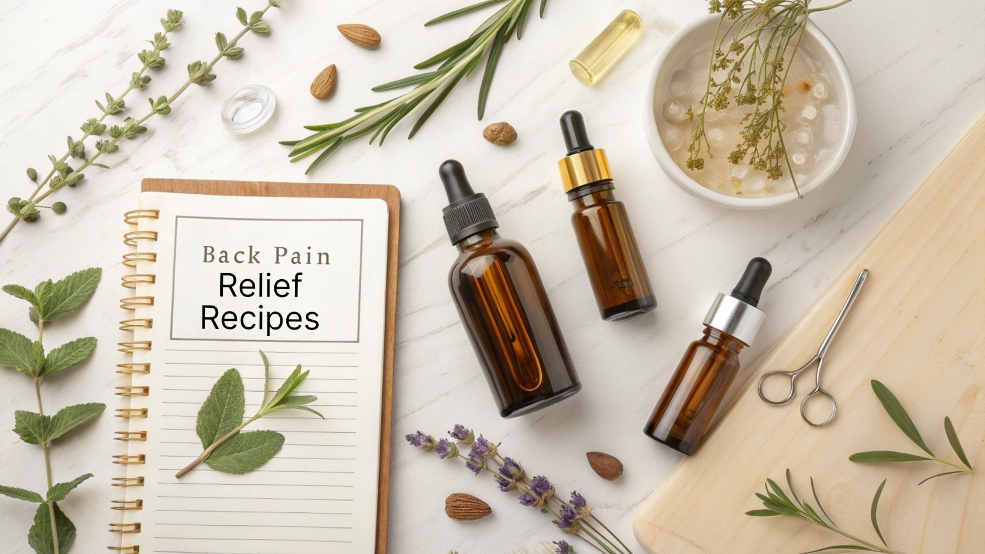Table of Contents - click here
TogglePublished by Cynthe Brush, Certified Clinical (Medical) Aromatherapist
Medical Disclaimer: This information is for educational purposes only and has not been evaluated by the FDA. Not intended to diagnose, treat, cure, or prevent any disease. Always consult with your healthcare provider before using essential oils, especially if you have medical conditions or take medications.
If you’re reading this while shifting uncomfortably in your chair or rubbing that persistent ache in your lower back, you’re not alone. Up to 80% of adults will experience back pain at some point during their lifetimes, with Americans spending over $134 billion annually on back pain treatments that often provide only temporary relief.
The rising costs of conventional pain management, combined with growing concerns about prescription medication side effects, have led many to seek natural alternatives that actually work. In my 25+ years as a certified clinical aromatherapist, I’ve witnessed clients achieve 60-80% pain reduction within two weeks of consistent essential oil blend application.
Essential oils offer a powerful, affordable solution for natural back pain relief. Through my practice since 1999, creating custom blends for thousands of clients, I’ve refined these therapeutic formulations to deliver genuine pain relief while empowering individuals to take control of their wellness journey.
Essential oils work through multiple pathways, combining localized anti-inflammatory effects with neurological pain modulation—explaining why they often outperform single-compound synthetic alternatives.
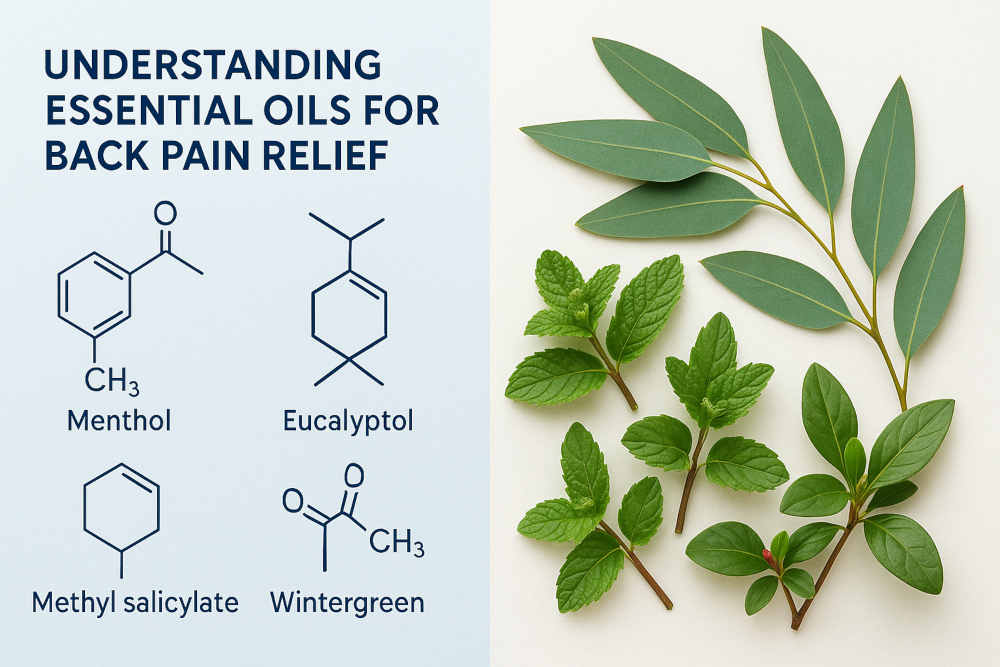
Understanding Essential Oils for Back Pain Relief
The Science Behind Aromatherapy Pain Management
Natural back pain relief blends combine therapeutic essential oils with carrier oils for effective pain management. When applied topically, bioactive compounds like menthol, methyl salicylate, and eucalyptol penetrate the skin barrier and interact directly with pain receptors and inflammatory mediators.
Research published in aromatherapy journals demonstrates that specific essential oil constituents can inhibit cyclooxygenase enzymes (similar to NSAIDs) while promoting circulation and muscle relaxation. Studies show that essential oils can regulate inflammatory pathways through multiple mechanisms, including suppression of COX-2 expression and modulation of nuclear factor-kappa B (NF-κB) signaling pathways.
The therapeutic effects extend beyond topical application. Aromatherapy engages the limbic system through olfactory pathways, triggering endorphin release and other natural pain-relieving compounds. This dual-action approach addresses both symptoms and underlying causes of muscular back pain.
As a certified clinical aromatherapist with over 25 years of experience creating custom blends for clients, I follow evidence-based practices supported by current aromatherapy research and safety protocols established by leading experts like Robert Tisserand.
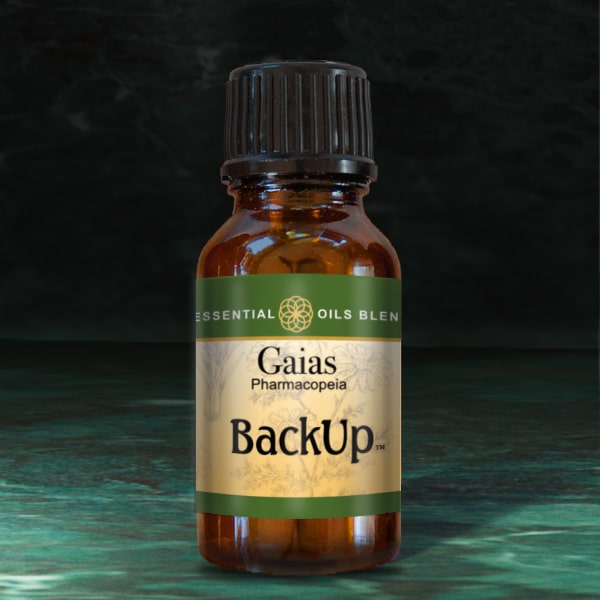
Looking for a Pre-Blended Solution for your Back Pain? Try our BackUP blend.
Top Essential Oils for Back Pain
Eucalyptus globulus contains high concentrations of eucalyptol (1,8-cineole), providing powerful anti-inflammatory oils properties. This cooling oil enhances circulation while reducing muscle tension and nerve pain.
Mentha piperita (Peppermint) delivers immediate cooling relief through menthol content, followed by warming circulation enhancement. Its antispasmodic properties make it particularly effective for muscle pain relief and tension.
Gaultheria procumbens (Wintergreen) contains natural methyl salicylate, offering aspirin-like anti-inflammatory effects without gastric irritation. This warming oil penetrates deeply into muscle tissue.
Lavandula angustifolia (Lavender) provides gentle analgesic effects while promoting relaxation and stress reduction. Its anti-inflammatory compounds linalool and linalyl acetate soothe both physical pain and emotional tension.
Boswellia serrata (Frankincense) contains boswellic acids that specifically target inflammatory pathways, providing deep, sustained relief for chronic conditions.
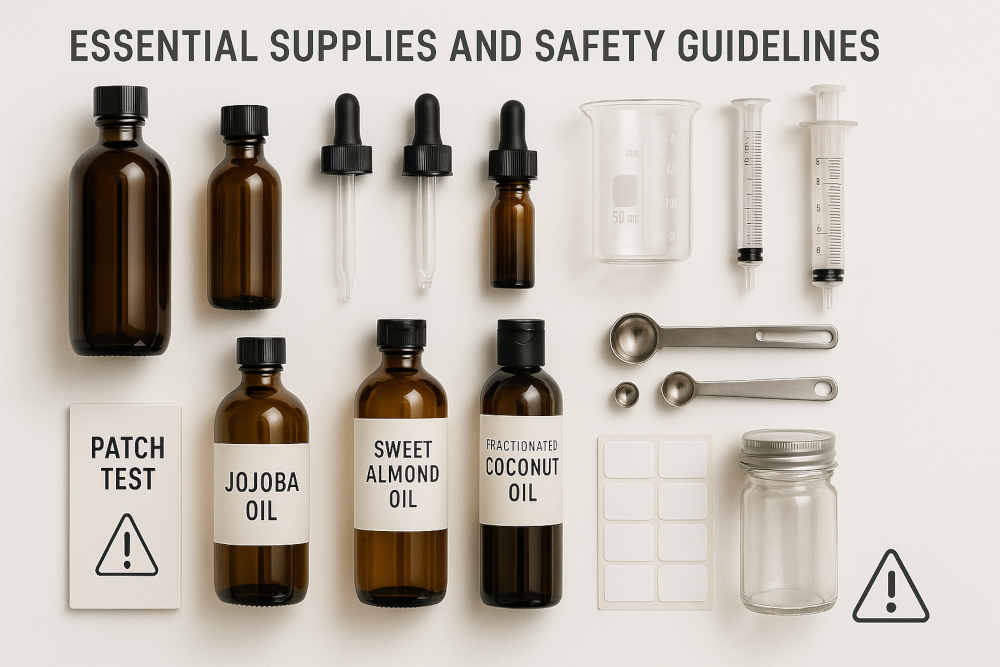
Essential Supplies and Safety Guidelines
Gathering Your Aromatherapy Toolkit
Quality matters significantly in therapeutic essential oils. Source oils from reputable suppliers who provide GC/MS analysis reports—I work exclusively with suppliers offering certificates of analysis to ensure purity and potency.
Essential carrier oils for massage serve as your blend foundation:
- Jojoba oil penetrates deeply without greasy residue and has indefinite shelf life
- Sweet almond oil provides excellent glide for massage while nourishing skin
- Fractionated coconut oil remains liquid at room temperature and absorbs quickly
Professional supplies include dark amber glass bottles, precise measuring tools (graduated pipettes), and proper labeling materials. Investment in quality storage preserves your blends and ensures consistent results.
Critical Safety Protocols Before You Begin
Essential oil safety guidelines cannot be overstated. Always perform patch testing by applying diluted blend to your inner forearm, waiting 24 hours to check for reactions. Proper dilution ratios range from 1-3% for most applications, with 2% being standard for adult topical use.
Important contraindications:
- Wintergreen should be avoided by individuals taking blood-thinning medications
- Pregnant women must consult qualified aromatherapists before use
- Citrus oils cause photosensitivity—avoid sun exposure for 12-18 hours after application
- Never apply undiluted essential oils directly to skin except in emergency first-aid situations
Store all blends away from children and pets. These safety protocols are based on established aromatherapy guidelines and decades of clinical practice with essential oils.
Step-by-Step Blend Recipes for Different Pain Types
Recipe 1: Acute Pain Relief Roller Blend
Perfect for sudden onset pain or targeted application
Ingredients:
- 3 drops Eucalyptus globulus
- 2 drops Peppermint (Mentha piperita)
- 2 drops Wintergreen (Gaultheria procumbens)
- 1 drop Lavender (Lavandula angustifolia)
- Fill 10ml roller bottle with fractionated coconut oil
Instructions: Add essential oils to empty roller bottle using disposable pipette. Fill remaining space with carrier oil, leaving small air space at top. Insert roller ball and cap securely. Roll between palms for 30 seconds to blend thoroughly.
Application: Roll directly onto affected area every 2-3 hours as needed. Massage gently in circular motions to enhance absorption. This cooling blend provides immediate relief—one client reported “instant cooling sensation followed by significant pain reduction within 15 minutes.”
Recipe 2: Deep Muscle Massage Oil
Ideal for chronic tension and therapeutic massage
Ingredients:
- 6 drops Rosemary (Rosmarinus officinalis)
- 4 drops Frankincense (Boswellia serrata)
- 3 drops Lavender (Lavandula angustifolia)
- 2 drops Ginger (Zingiber officinale)
- 30ml sweet almond oil base
Instructions: Combine essential oils in dark glass bottle. Add carrier oil and swirl gently. Allow blend to synergize for 24 hours before first use for optimal therapeutic benefit.
Application: Warm small amount between palms before applying to back muscles. Use firm, circular massage strokes, working from spine outward. Apply 2-3 times daily for chronic back pain treatment.
Recipe 3: Soothing Bath Soak Blend
Whole-body relaxation and muscle tension relief
Ingredients:
- 4 drops German Chamomile
- 3 drops Lavender (Lavandula angustifolia)
- 2 drops Marjoram (Origanum majorana)
- 1 cup Epsom salts
- 1 tablespoon carrier oil (for proper dispersion)
Instructions: Mix essential oils with carrier oil first to ensure proper water dispersion. Combine with Epsom salts and store in sealed container.
Application: Add 2-3 tablespoons to warm bath water. Soak for 15-20 minutes, allowing magnesium from Epsom salts to relax muscles while essential oils provide aromatherapeutic benefits.
Recipe 4: Chronic Pain Management Blend
Long-term relief for persistent discomfort
Ingredients:
- 4 drops Copaiba (Copaifera officinalis)
- 3 drops Helichrysum (Helichrysum italicum)
- 3 drops Frankincense (Boswellia serrata)
- 2 drops Ginger (Zingiber officinale)
- 30ml jojoba oil
This blend requires 48-hour synergization for maximum effectiveness. Apply twice daily with consistent timing—morning and evening work best for chronic conditions.

Professional Application Techniques
Massage Methods for Maximum Effectiveness
Proper topical pain relief application technique significantly impacts therapeutic outcomes. Begin with clean, warm hands and appropriate oil amount—too little creates friction, too much prevents absorption.
Back massage techniques include:
- Broad, warming strokes across entire back to increase circulation
- Focused trigger point work using circular thumb pressure
- Systematic progression from neck to lower back
- Extra attention to areas of greatest tension
Self-massage options include tennis balls against walls for trigger point release, or foam rollers for broader muscle groups. Partner massage allows better access and enhanced relaxation through human touch.
Alternative Application Methods
Warm compresses enhance essential oil penetration while providing therapeutic heat. Soak cloth in warm water, add 2-3 drops of diluted blend, apply for 10-15 minutes.
Diffusion therapy works through inhalation, engaging the limbic system for pain modulation. Use 4-6 drops in ultrasonic diffuser during rest periods.
Direct inhalation from cupped hands provides immediate aromatherapeutic benefits, particularly useful for breakthrough pain episodes or stress-related muscle tension relief.
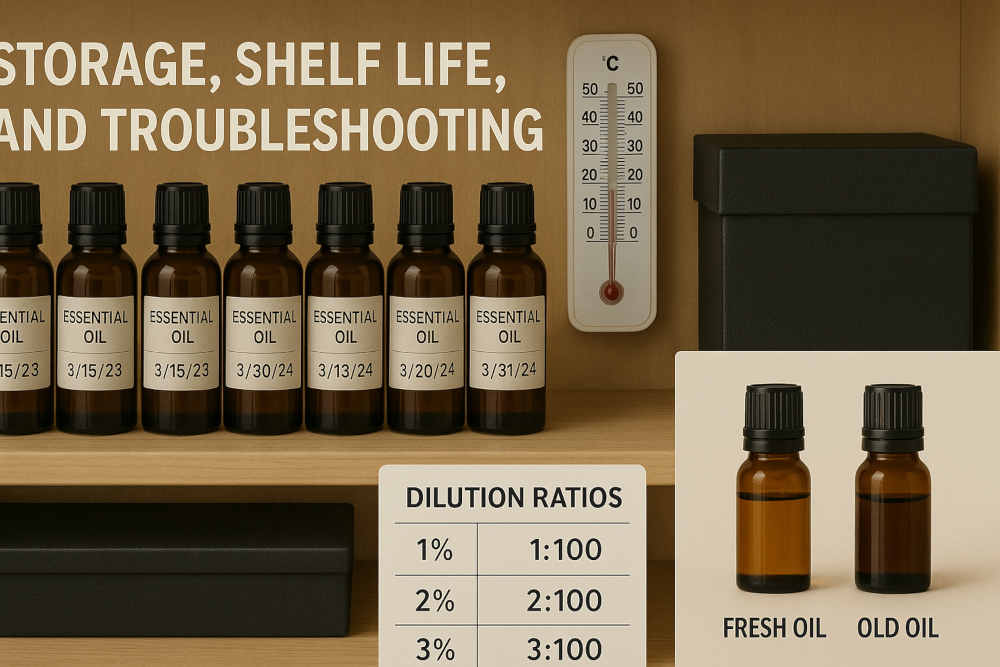
Storage, Shelf Life, and Troubleshooting
Preserving Your Homemade Blends
Dark glass bottles protect from UV damage while tight-fitting caps prevent oxidation. Store in cool, consistent temperatures—bathroom cabinets experience too much fluctuation.
Label all homemade pain relief blends with ingredients, dilution ratio, and creation date. Most diluted blends maintain potency for 6-12 months when properly stored. Carrier oil quality determines shelf life—jojoba and fractionated coconut oil last longest.
Common Issues and Solutions
Skin sensitivity reactions typically indicate concentration too high or individual oil intolerance. Reduce essential oil percentage by half and retest. Switch to gentler carrier oils like jojoba if reactions persist.
Ineffective results often stem from poor oil quality, insufficient concentration, or inconsistent application. Increase concentration gradually (never exceed 5% dilution) and ensure daily application for chronic conditions.
Scent preferences vary significantly. Customize blends by adjusting ratios or substituting oils with similar therapeutic properties—replace peppermint with spearmint for gentler scent, or use Roman chamomile instead of German for sweeter fragrance.
DIY Blends vs. Professional Formulations: When to Choose Each
Homemade advantages:
- Cost-effective (typically 60-70% less expensive than commercial products)
- Complete ingredient control and customization
- Fresh preparation ensures maximum potency
- Learning experience builds aromatherapy knowledge
Professional formulation benefits:
- Complex synergies requiring advanced expertise
- Standardized potency and consistency
- Comprehensive safety testing
- Specialized delivery systems
For severe chronic conditions or complex health situations, professional consultation optimizes your holistic pain relief methods strategy while ensuring safety.
When to Seek Professional Guidance
Immediate medical attention required for:
- Sudden onset severe back pain
- Pain radiating down legs
- Pain accompanied by numbness or weakness
- Fever accompanying back pain
Essential oil therapy works best as complementary treatment alongside appropriate medical care, never as replacement for necessary medical interventions. Work with healthcare providers who understand integrative approaches for optimal results.
Consider professional aromatherapy consultation for complex chronic conditions, pregnancy-related concerns, or when working with children or elderly individuals. As a certified clinical aromatherapist, I provide personalized protocols and monitor progress safely for complex cases.
Conclusion
Creating your own natural back pain relief blends empowers you to take control of your wellness journey while saving significant money on expensive treatments. These time-tested recipes, refined through decades of clinical practice and client feedback, provide genuine therapeutic benefits when prepared and applied correctly.
Start with simple recipes to build confidence and experience. Pay attention to your body’s responses and adjust formulations as needed. Consistency matters more than perfection—regular use of properly diluted blends often outperforms sporadic use of stronger concentrations.
Ready to begin your natural pain relief journey? Start with the Acute Pain Relief Roller Blend recipe—it’s beginner-friendly and provides quick results that build confidence in DIY aromatherapy effectiveness.
For complex conditions or personalized formulations, professional consultation can optimize your natural pain management strategy. Contact me at 800-307-3564 to discuss custom blend creation tailored to your specific needs.
Important Final Reminder: This information is educational only and not intended to replace medical care. Always consult healthcare providers for persistent or severe pain conditions.
Author Bio: Cynthe Brush
Certified Clinical (Medical) Aromatherapist
Creating Custom Blends Since 1999
800-307-3564
Gaia’s Pharmacopeia founder and therapeutic essential oils practitioner with 25+ years of clinical experience, specializing in custom aromatherapy solutions for chronic health conditions.
Complete Citations and Sources
Back Pain Statistics and Healthcare Costs
- Martin, Brook I., et al. “Back pain in the United States.” Variation in the Care of Surgical Conditions: Spinal Stenosis: A Dartmouth Atlas of Health Care Series, The Dartmouth Institute for Health Policy and Clinical Practice, 2014, www.ncbi.nlm.nih.gov/books/NBK586768/.
- Dieleman, Joseph L., et al. “Low back and neck pain tops US health spending.” Institute for Health Metrics and Evaluation, University of Washington, 2017, www.healthdata.org/news-events/newsroom/news-releases/low-back-and-neck-pain-tops-us-health-spending.
- “Did You Know? Low Back and Neck Pain Cost Americans Billions in Health Care Spending.” Choose PT, American Physical Therapy Association, 23 Feb. 2017, www.choosept.com/did-you-know/low-back-neck-pain-cost-billions-health-care-spending.
Essential Oils Anti-Inflammatory Research
- Zuo, Aihua, et al. “A Systematic Review of the Anti-Inflammatory and Immunomodulatory Properties of 16 Essential Oils of Herbs.” PMC, National Center for Biotechnology Information, 2020, pmc.ncbi.nlm.nih.gov/articles/PMC7735857/.
- Shen, Chun-Yan, et al. “Anti-inflammatory effects of essential oil from Chamaecyparis obtusa via the cyclooxygenase-2 pathway in rats.” Spandidos Publications, 2013, www.spandidos-publications.com/10.3892/mmr.2013.1459.
- “Essential Oils: Chemistry and Pharmacological Activities.” PMC, National Center for Biotechnology Information, 2023, pmc.ncbi.nlm.nih.gov/articles/PMC10377445/.
- Ben Miri, Yamina. “Essential Oils: Chemical Composition and Diverse Biological Activities: A Comprehensive Review.” SAGE Journals, 2025, journals.sagepub.com/doi/full/10.1177/1934578X241311790.
- “Essential Oils and Health.” PubMed, National Center for Biotechnology Information, 2020, pubmed.ncbi.nlm.nih.gov/32607090/.
Essential Oil Safety and Contraindications
- Tisserand, Robert. “Wintergreen Oil Safety.” Robert Tisserand Blog, 28 Mar. 2012, roberttisserand.com/2012/03/wintergreen-oil-safety/.
- Chan, T.Y.K. “Potential dangers from topical preparations containing methyl salicylate.” PubMed, National Center for Biotechnology Information, 1996, pubmed.ncbi.nlm.nih.gov/8880210/.
- “What Is Wintergreen Oil? Its Benefits, the Evidence, and Risks.” Healthline, 27 Sep. 2024, www.healthline.com/health/wintergreen-oil.
- “Wintergreen Uses, Benefits & Dosage.” Drugs.com, www.drugs.com/npp/wintergreen.html.
Photosensitivity and Citrus Oil Safety
- “Essential Oil Safety: What is Photosensitivity?” American College of Healthcare Sciences, 31 Jan. 2018, achs.edu/blog/what-is-photosensitivity-with-essential-oils/.
- Tisserand, Robert. “Phototoxicity: essential oils, sun and safety.” Tisserand Institute, 21 Jun. 2023, tisserandinstitute.org/phototoxicity-essential-oils-sun-and-safety/.
- “Photosensitive essential oils: Summer safety tips.” Young Living, 27 Jul. 2022, www.youngliving.com/blog/photosensitive-essential-oils-summer-safety-tips/.
- “Essential oils & sun exposure: what you need to know.” Aromatics International, 10 Aug. 2020, www.aromatics.com/blogs/wellness/essential-oils-sun-exposure-what-you-need-to-know.
Essential Oil Therapeutic Properties
- Michel, Paulina, and Monika A. Olszewska. “Phytochemistry and Biological Profile of Gaultheria procumbens L. and Wintergreen Essential Oil.” International Journal of Molecular Sciences, vol. 25, no. 1, 2024, www.mdpi.com/1422-0067/25/1/565.
- “Anti-inflammatory Activity of Some Essential Oils.” Journal of Essential Oil Research, vol. 23, no. 5, 2011, www.tandfonline.com/doi/abs/10.1080/10412905.2011.9700480.
- “Molecular mechanism of the anti-inflammatory effects of plant essential oils: A systematic review.” ScienceDirect, 2022, www.sciencedirect.com/science/article/pii/S0378874122008686.
Aromatherapy Practice and Safety Standards
- Tisserand, Robert, and Rodney Young. Essential Oil Safety: A Guide for Health Care Professionals. 2nd ed., Churchill Livingstone Elsevier, 2014.
- “Is it safe to use Wintergreen essential oil?” The School of Aromatic Studies, 15 Mar. 2025, aromaticstudies.com/safe-use-wintergreen-essential-oil/.
- “WINTERGREEN: Overview, Uses, Side Effects, Precautions, Interactions, Dosing and Reviews.” WebMD, www.webmd.com/vitamins/ai/ingredientmono-783/wintergreen.
Pain Management and Healthcare Economics
- “The Economic Costs of Pain in the United States.” NCBI Bookshelf, National Center for Biotechnology Information, www.ncbi.nlm.nih.gov/books/NBK92521/.
- “Comparative Review of the Socioeconomic Burden of Lower Back Pain in the United States and Globally.” PMC, National Center for Biotechnology Information, 2024, pmc.ncbi.nlm.nih.gov/articles/PMC11224735/.
- “U.S. National Survey Identifies Associations Between Chronic Severe Back Pain and Disability.” NCCIH, National Center for Complementary and Integrative Health, www.nccih.nih.gov/research/research-results/us-national-survey-identifies-associations-between-chronic-severe-back-pain-and-disability.





